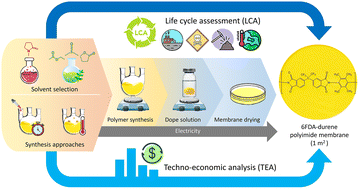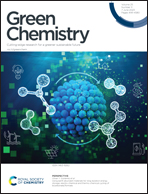Are green solvents truly green? Integrating life cycle assessment and techno-economic analysis for sustainable membrane fabrication†
Abstract
Despite attempts to reinforce the significance of solvent selection, the adoption of green solvents is relatively immature since their practicality remains unclear in the membrane arena. This work demonstrated the integration of life cycle assessment (LCA) and techno-economic analysis (TEA) to appraise both environmental and economic perspectives of green solvents in fabricating 1 m2 of polyimide flat sheet membranes. This analysis compared the impacts of a conventional solvent and three green solvents, namely N-methyl-2-pyrrolidone (NMP), dimethyl sulfoxide (DMSO), ethyl acetate (EA), and γ-butyrolactone (GBL). Other than the solvents, the impacts of two different synthesis methods such as chemical imidization and one-step high temperature polymerization were investigated. The impact assessment indicated that the membrane preparation process imposed the greatest environmental burden on human health due to toxicity impacts. Noticeable impact decrements were spotted by replacing NMP with a less toxic green solvent in membrane fabrication. However, a green solvent such as DMSO was less competitive in terms of production costs. Integrating the results from LCA and TEA, DMSO and EA were suggested as potential green solvents by virtue of their decent environmental performance and costs. The impact of synthesis approaches was negligible based on the findings, but is anticipated to be more evident when the membrane production process is scaled up.



 Please wait while we load your content...
Please wait while we load your content...